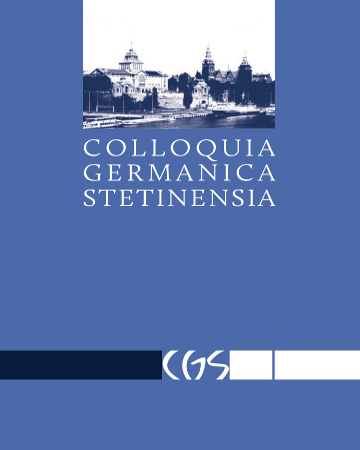







| Authors: |
Anna
Pilarski
Uniwersytet Szczeciński |
| Keywords: | Verb in the sentence INFL phrase structure Minimalist Program Generative grammar: Principles and parameters theory Comparative syntax of Yiddish, Polish and German |
| Data publikacji całości: | 2015 |
| Page range: | 18 (191-208) |
| Downloads ?: | 568 |
| 1. | ABRAHAM, Werner (1995, 20052a): Deutsche Syntax im Sprachenvergleich: Grundlegung einer typologischen Syntax des Deutschen. 2., verbesserte und erweiterte Aufl. Tübingen. |
| 2. | ABRAHAM, Werner (Hg.) (2005b): Focus on Germanic Typology. Studia Typologica 6. Berlin. |
| 3. | ADAMS, Marianne (1987): From Old French to the Theory of Pro-Drop. In: Natural Language and Linguistic Theory 1., S. 1–32. |
| 4. | DIESING, Molly (1997): Yiddish VP Order and the Typology of Object Movement in Germanic. Natural Language & Linguistic Theory 15.2., S. 369–427. |
| 5. | DIESING, Molly (2005): The Upper Functional Domain in Yiddish. In: W. Abraham (Hg.): Deutsche Syntax im Sprachenvergleich: Grundlegung einer typologischen Syntax des Deutschen. 2., verbesserte und erweiterte Aufl. Tübingen, S. 195–209. (Verfügbar über: ht |
| 6. | DÜRSCHEID, Christa (1991): Modelle der Satzanalyse. Überblick und Vergleich. Hürth. |
| 7. | ENGEL, Ulrich (2004, 20092b): Deutsche Grammatik – Neubearbeitung. München. |
| 8. | FANSELOW, Gisbert (2014): Quirky “subjects” and other specifiers. In: I. Kaufmann, B. Stiebels (Hg.): More than words. A Festschrift for Dieter Wunderlich. Studia grammatica 53. Berlin, S. 227–250. (Verfügbar über: www.ling.unipotsdam.de/~fanselow/files/F |
| 9. | FANSELOW, Gisbert/FELIX, Sascha (Hg.) (1991): Strukturen und Merkmale syntaktischer Kategorien. Tübingen. |
| 10. | FANSELOW, Gisbert/FELIX, Sascha (1993): Sprachtheorie 2: Rektions- und Bindungstheorie. Tübingen. |
| 11. | FREIDIN, Robert (Hg.) (1991): Principles and Parameters in Comparative Grammar. Cambridge. |
| 12. | FUKUI, Naoki/SPEAS, Margaret (1986): Specifiers and Projection. In: MIT Working Papers in Linguistics 8 (1986), S. 128–172. |
| 13. | GREWENDORF, Günther (1995): Sprache als Organ – Sprache als Lebensform. Frankfurt a. M. |
| 14. | GREWENDORF, Günther (1988): Aspekte der deutschen Syntax. Eine Rektions-Bindungs-Analyse. Tübingen. |
| 15. | GREWENDORF, Günther (2002): Minimalistische Syntax. Tübingen. Basel. |
| 16. | GREWENDORF, Günther/HAMM, Fritz/STERNEFELD, Wolfgang (1987, 81996): Sprachliches Wissen: Eine Einführung in moderne Theorien der grammatischen Beschreibung. Frankfurt a. M. |
| 17. | HOLMBERG, Anders (1993): On the structure of predicate NP. In: Studia Linguistica 47(2), S. 126–138. |
| 18. | HOLMBERG, Anders (1999): Remarks on Holmberg’s Generalization. In: Studia Linguistica 53(1), S. 1–39. |
| 19. | KAUFMANN, Ingrid/STIEBELS, Barbara (Hg.) (2014): More than words. A Festschrift for Dieter Wunderlich. Studia grammatica 53. Berlin. |
| 20. | LÖTZSCH, Ronald (1992, 22013): Jiddisches Wörterbuch. Berlin, Mannheim, Zürich. |
| 21. | MOHR, Sabine (2005): Eine Antwort auf die Frage, wo dem Jiddischen der Kopf steht. Tübingen. (Verfügbar über: http://ifla.uni-stuttgart.de/files/ggs_2005.pdf; 08.04.2014.) |
| 22. | PHILIPPI, Jule (2008): Einführung in die generative Grammatik. Gottingen. (Verfügbar über: http://books.google.pl/books?id=XYZUKv-iSkkC&pg=PA82&lpg=PA82&dq=SOV+in+generative+grammatik&source=bl&ots=6w2YCCf-jr&sig=Sf1Rr7bIgdlSP5MlJ6IhAgFsLWI&hl=pl&sa=X&ei= |
| 23. | PILARSKI, Anna (2002): Die Operation „Merge“ im Verbalkomplex des Polnischen und des Deutschen. Frankfurt a. M. |
| 24. | PILARSKI, Anna (2013): Das Nullsubjekt im Polnischen. Dependenzielle Verbgrammatik und Generative Transformationsgrammatik im Modellvergleich. München. |
| 25. | SADOCK, Jerrold (1998): A Vestige of Verb Final Syntax in Yiddish. In: Monatshefte für deutschsprachige Literatur und Kultur. University of Wisconsin at Madison 90, S. 220–226. |
| 26. | SALONI, Zygmunt/ŚWIDZIŃSKI, Marek (1981, 41998): Składnia współczesnego języka polskiego. Warszawa. |
| 27. | SANTORINI, Beatrice (1993a): The rate of phrase structure change in the history of Yiddish. In: Language Variation and Change 5, S. 257–283. |
| 28. | SANTORINI, Beatrice (1993b): Das Jiddische als OV/VO Sprache. In: Linguistische Berichte 123, S. 230–245. |
| 29. | SCHALLERT, Oliver (2007): Wortstellungstypologie des Jiddischen im Spannungsfeld zwischen den germanischen und den slawischen Sprachen. Manuskript. Universität Marburg. (Verfügbar über: www.uni-marburg.de/fb09/igs/mitarbeiter/schallert/schallertjiddisch.p |
| 30. | SONG, Seok-Hee (2002): Eine vergleichende Analyse von Scrambling im Deutschen und Koreanischen. Dissertation. Philosophische Fakultät II der Humboldt-Universität zu Berlin. Berlin. (Verfügbar über: http://edoc.hu-berlin.de/dissertationen/song-seok-hee-200 |
| 31. | TRAVIS, Lisa (1991): Parameters of Phrase Structure and Verb Second Phenomena. In: R. Freidin (Hg.): Principles and Parameters in Comparative Grammar. Cambridge, S. 339–364. |
| 32. | VATER, Heinz (1987, 42002): Einführung in die Sprachwissenschaft. 4. vollständig überarbeitete und erweiterte Aufl. München. |
| 33. | VIKNER, Sten (2013): Verb Particles in Germanic SVO- and SOV languages: Yiddish compared to Danish and German. SyntaxLab Dept. of Theoretical and Applied Linguistics University of Cambridge, 14.05.2013. (Verfügbar über: www.hum.au.dk/engelsk/engsv/handout |
| 34. | WALLENBERG, Joel C. (2013): Scrambling, LF, and Phrase Structure Change in Yiddish. In: Lingua (Amsterdam) 133, S. 289–318. |
| 35. | WEISSBERG, Josef (1988): Jiddisch. Eine Einführung. Bern, Frankfurt a. M., New York, Paris. |